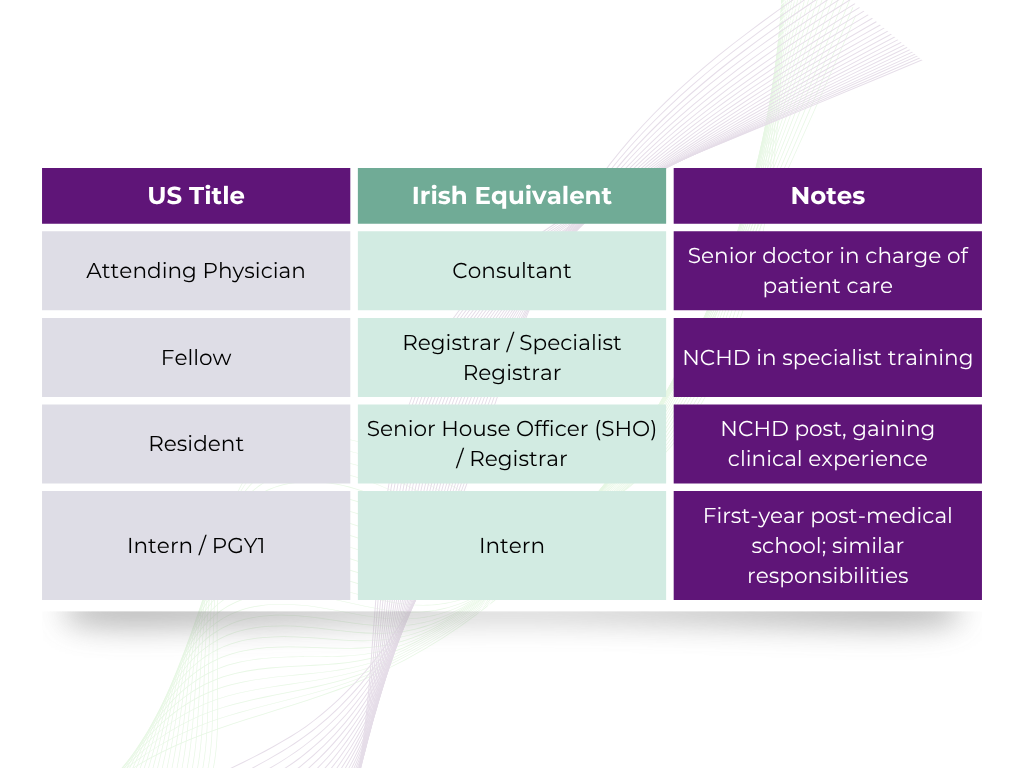For US-trained attending physicians, or who we refer to in Ireland as consultants, considering a move to Ireland, understanding how the healthcare system works including job titles, training pathways, and career progression is essential. While Ireland offers exciting opportunities, the structure can feel different at first. Here’s a detailed breakdown.
Healthcare Structure: US vs Ireland
United States:
- Largely private-based, though Medicare and Medicaid provide public coverage
- Hospitals can be public, private, or academic
- Consultants usually called Attending Physicians
- Training path: Medical School → Residency → Fellowship → Attending
Ireland:
- Public healthcare system primarily run by the HSE (Health Service Executive), with a private sector as well
- Doctors employed in hospitals or clinics, public or private
- Senior doctors are called Consultants (equivalent to US Attending Physicians)
- Training path: Medical School → Internship → Non-Consultant Hospital Doctor (NCHD) roles → Specialist Training → Consultant
Key Takeaway: A US Attending is equivalent to an Irish Consultant. NCHDs are somewhat like US Fellows or Senior Residents gaining supervised experience.
Job Titles: Mapping US to Ireland

Tip: In Ireland, you may also see “Non-Training NCHD” roles, these are service posts not linked to specialist training but offer valuable clinical experience and a pathway to consultant eligibility.
Training and Career Progression
US: Residency and Fellowship are time-bound and highly structured. Consultants/Attendings assume independent responsibility after completion.
Ireland:
- Postgraduate training is flexible. NCHD roles may last a few years before entry into specialist training.
- Specialist training can be competitive; international doctors may need supervised practice initially.
- Once a doctor completes specialist registration, they are eligible for Consultant posts.
Tip for US doctors: You may find the transition smoother than for other international doctors because the US training system is highly structured and recognised internationally.
Work Environment and Culture
Similarities:
- Both countries value patient safety, evidence-based practice, and teamwork
- Consultants have leadership roles and supervise junior doctors
- Academic opportunities exist in major hospitals
Differences:
- Ireland generally offers more predictable work-life balance, with defined working hours and leave policies
- US hospitals may have more administrative burden and complex insurance paperwork
- In Ireland, many NCHD posts involve rotation across hospitals to gain diverse experience
Visa and Registration Considerations for US Doctors
- US-trained doctors need IMC registration to practice (specialist registration for consultant roles)
- Critical Skills Employment Permit facilitates relocation and family integration
- MatchMedics can support US doctors with credential verification, registration, and employment placement
- After securing the permit and registration, you must apply for a visa (if required) and register with the Garda National Immigration Bureau (GNIB) upon arrival to secure your long-term permission to live and work in Ireland.
Lifestyle Advantages in Ireland
- English-speaking, culturally familiar environment
- Proximity to Europe for travel
- Friendly, collaborative hospital teams
- Opportunities for private practice or combined public/private work
Summary
While US and Irish healthcare systems differ in structure and terminology, the roles are comparable: US Attendings transition naturally into Irish Consultant positions. Understanding the career pathways, terminology, and work culture ensures US doctors make a smooth move and hit the ground running.
